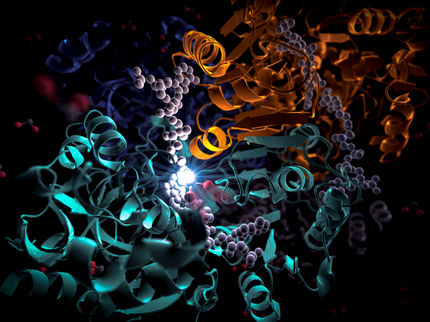Tracking Down the Scent of Sweat
Researchers identify new sulfur-containing scent molecules in sweat
Advertisement
Sometimes, people just don't smell good - and not only in the figurative sense. The sense of smell plays an important role in interpersonal relations. The human armpit contains chemical substances that - at least in premodern times - probably provided direction for the selection of a genetically compatible partner for reproduction. The average modern nose is offended by strong bodily odors, and the smell of perspiration is scorned by our society. The typical smell associated with the human armpit is caused by a cocktail of odorous substances, including various androstenone derivatives and certain volatile fatty acids, as well as sulfur-containing compounds about which little has been previously known. Two Swiss research teams have now identified several of the main sulfur-containing components, as well as a bacterial enzyme that seems to be responsible for the release of these compounds.
A team headed by Anthony J. Clark at the Swiss company Firmenich SA enlisted 30 volunteers to work up a heavy sweat on exercise machines and in a sauna. The sweat from their armpits was collected and sterilized. Normally, the secretions released by the many sweat glands in the underarm region are initially odorless. The human armpit, however, is the home of a diverse population of bacteria, mostly strains of Corynebacteria and Staphylococcus, that transform the components of sweat into strongly odorous substances. Through experiments with bacteria from human underarm skin, the researchers determined that different strains of bacteria produce different scents. "Of the micro-organisms we tested, Staphylococcus haemolyticus produced the most sulfurous scent," reports Clark. Isolation and analysis of these decomposition products by gas chromatography, mass spectroscopy, and the trained noses of perfumers revealed the presence of at least eight sulfanyl alcohols - compounds containing both OH and SH groups. One of these was identified as 3-methyl-3-sulfanylhexan-1-ol, which is present at a concentration of 4 ppb (one particle per every billion particles of fluid). The atoms in this molecule can be arranged in two ways, as two mirror-image forms of the molecule. While the (S)-form (S from the Latin, sinister = left) smells of sweat and onion, the scent of the mirror-image (R)-form (R from the Latin, rectus = right) is described as fruity and grapefruit-like. "The sweat broken down by S. haemolyticus contained the (S)- and (R)-forms in a 3:1 ratio," says Clark.
A second team also reports on the subject of 3-methyl-3-sulfanylhexan-1-ol as a component of underarm sweat. Scientists working with Andreas Natsch of Givaudan Schweiz AG also identified three additional sulfanyl alcohols of similar structure and equally pungent odor. The company has patented one of the substances as a potential component for oniony, meat-like flavors. Another is known as an aromatic substance found in passion fruit and cabernet wines. That these compounds produce such intense odors even at extremely low concentrations in sweat is a result of their unusually low detection threshold; they are perceived at concentrations of a mere few picograms (trillionths of grams) per liter of air. This is a factor of a thousand lower than the concentration at which average odors are perceived.
"The sulfanyl alcohols are secreted by sweat glands as odorless precursors containing the amino acid cysteine," Natsch is convinced. "Bacterial enzymes that can break carbon-sulfur bonds release the sulfanyl alcohols from these conjugates." Natsch's team was able to isolate the gene that codes for the enzyme cystathionine-b-lyase from corynebacteria. They transferred the gene to E. coli bacteria and the lyase obtained from the genetically modified E. coli transformed samples of odorless armpit sweat to emit typical pungent underarm scent within a few minutes.
Most read news
Other news from the department science

Get the chemical industry in your inbox
By submitting this form you agree that LUMITOS AG will send you the newsletter(s) selected above by email. Your data will not be passed on to third parties. Your data will be stored and processed in accordance with our data protection regulations. LUMITOS may contact you by email for the purpose of advertising or market and opinion surveys. You can revoke your consent at any time without giving reasons to LUMITOS AG, Ernst-Augustin-Str. 2, 12489 Berlin, Germany or by e-mail at revoke@lumitos.com with effect for the future. In addition, each email contains a link to unsubscribe from the corresponding newsletter.
Most read news
More news from our other portals
See the theme worlds for related content
Topic world Gas chromatography
Gas chromatography is an essential method in analytical chemistry for the separation and analysis of volatile compounds. Due to its high resolution and sensitivity, it has become firmly established in areas such as environmental analysis, food chemistry or forensic science. GC provides precise and reliable results and enables deep insights into the chemical composition of samples.

Topic world Gas chromatography
Gas chromatography is an essential method in analytical chemistry for the separation and analysis of volatile compounds. Due to its high resolution and sensitivity, it has become firmly established in areas such as environmental analysis, food chemistry or forensic science. GC provides precise and reliable results and enables deep insights into the chemical composition of samples.
Topic World Spectroscopy
Investigation with spectroscopy gives us unique insights into the composition and structure of materials. From UV-Vis spectroscopy to infrared and Raman spectroscopy to fluorescence and atomic absorption spectroscopy, spectroscopy offers us a wide range of analytical techniques to precisely characterize substances. Immerse yourself in the fascinating world of spectroscopy!

Topic World Spectroscopy
Investigation with spectroscopy gives us unique insights into the composition and structure of materials. From UV-Vis spectroscopy to infrared and Raman spectroscopy to fluorescence and atomic absorption spectroscopy, spectroscopy offers us a wide range of analytical techniques to precisely characterize substances. Immerse yourself in the fascinating world of spectroscopy!
Last viewed contents
Huntsman to Increase MDI and MDI-based Systems Prices in Europe
Huntsman to Increase MDI and MDI-Based Systems Prices in Europe
History_of_thermodynamics
COX-2_inhibitor


























































